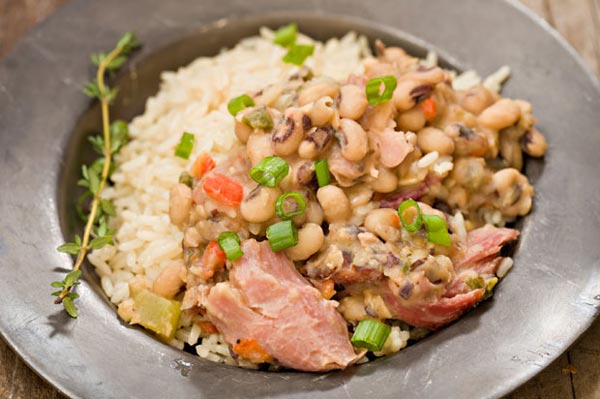Kay's Cooking Corner
December 30 - January 5, 2014
By Kay Bona
First observed in ancient Babylon about 4,000 years ago, the celebration of New Year’s Day is the oldest of all holidays. In the years around 2,000 B.C., the Babylonian New Year originally began with the first New Moon, after the Vernal Equinox, or first day of spring. However, with the Roman Senates’ constant tampering and changing of the early calendars, the celebration of New Year’s Day changed also.
In 1752, Great Britain and its colonies in America adopted the Gregorian calendar, where January 1 was restored as New Year’s Day.
Most Americans make resolutions, a tradition that also dates back to the Babylonians. The Babylonian’s most popular resolution was to return borrowed farm equipment, while one of our modern day resolutions might be a promise to lose weight or to quit smoking. I’m willing to bet returning borrowed equipment was much easier to follow through on.
At New Year’s Eve parties and in homes across the United States, watching television is part of the traditional celebration, as most of the major network channels air the events at Times Square in New York City. Since 1908, at one minute before midnight, a lighted ball drops slowly from a pole as everyone counts down the final minutes of the passing year and kiss and hug to the opening second of the New Year. Then everyone joins in and sings the song Auld Lang Syne.
On January 1st, people visit friends, relatives, and neighbors, and watch the Tournament of Roses Parade – preceding the Rose Bowl football game in Pasadena, Calif. There are other games to watch, too, such as the Orange Bowl, Cotton Bowl, or Sugar Bowl.
Whatever the custom or festivity we enjoy, most of us share the opinion that with a new year, we can make a new beginning, regardless of luck. We can wish each other good luck and promise ourselves to be a better person in the future.
Traditionally, it’s thought one can affect their luck throughout the remainder of the year by what they eat the first day. Many Americans begin the New Year by eating black-eyed peas with ham. Black-eyed peas and other legumes have been considered good luck in many cultures, and the hog symbolizes prosperity.
Other cultures believe anything in the shape of a ring is good luck, because it symbolizes “coming full circle.” For that reason, the Dutch eat donuts. That one sounds better than black-eyed peas!
The first recipes for Hoppin’ John appear in cookbooks dating back to the 1840s, although the mixture of dried peas, rice, and pork was made by Southern slaves long before then. It seems to have originated in the Low Country of South Carolina, an area where plantation owners searched long and hard for a crop that would flourish in the hot, muggy weather. Rice grew well in the river deltas, so it was a natural choice, but the white farmers had no real experience with cultivating rice on a large scale. Enter the slave trade and enslaved West Africans who had grown rice for generations.
The origins of the name “Hoppin’ John” are not as certain. Some say an old, hobbled man called Hoppin’ John became known for selling peas and rice on the streets of Charleston. Others say slave children hopped around the table in eager anticipation of the dish. Most food historians think the name derives from a French term for dried
peas – “pois pigeons.”
It’s also unclear how the dish became associated with New Year’s and good luck. The most likely story is that slaves would often have the period between Christmas and New Year’s off, since no crops were growing at that time. However, no one knows for sure.
Below is a traditional New Year’s Day recipe for Hoppin’ John. Believed to have originated with African slaves on Southern plantations, Hoppin’ John is a dish of black-eyed peas cooked with salt pork or ham hocks and seasonings, and then served with cooked rice. Tradition says eating Hoppin’ John on New Year’s Day brings good luck.
I don’t know if this brings good luck or not, but I do know that cooking up a pot of this hearty dish, some cornbread, and a few of your favorite deserts makes one incredible meal! Then invite your family and friends over to eat, drink, and be merry, creating a great beginning for a prosperous New Year. And maybe sneak in a donut for dessert! Happy 2014 to all of you!
Traditional Hoppin’ John
1 1/2 cups of dry black-eyed peas
1 pound of ham hocks or chopped ham
1 onion, chopped
1/2 teaspoon of crushed red pepper flakes
salt and pepper to taste
4 cups of water
1 1/2 cups of long-grain white rice
1 cup of shredded cheddar cheese
Place the peas, ham or ham hock, onion, red pepper, salt and pepper in a large pot. Cover with water and bring to a boil. Reduce heat to medium-low and cook for one and a half hours, until the beans are tender but not mushy. Remove the ham hock and cut the meat into pieces. Return the meat to the pot. Stir in the rice, cover, and cook until the rice is tender, about 20 to 25 minutes. Season to taste with salt and pepper. Sprinkle shredded cheese over the top, if desired.



